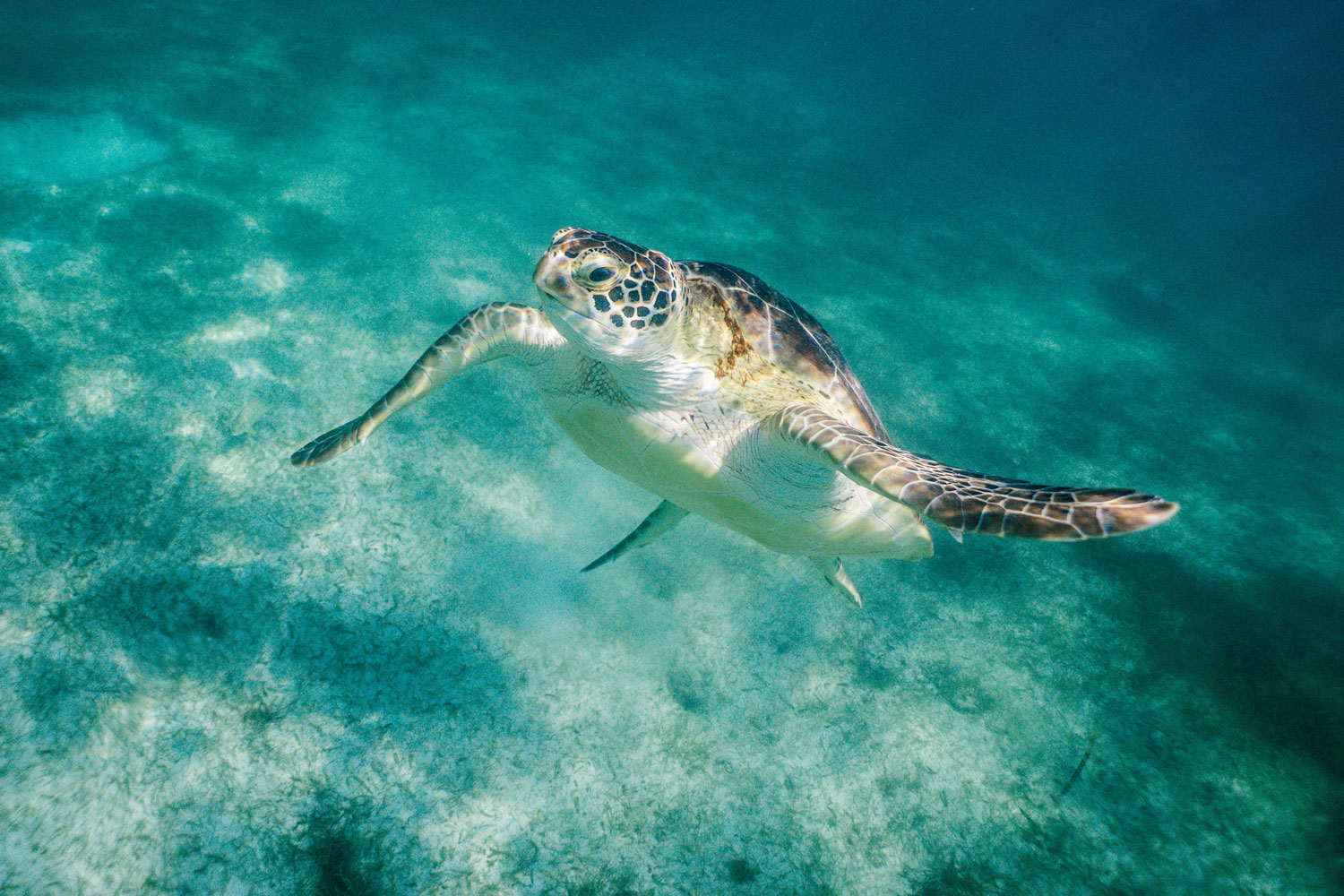Sea Turtle Nesting Season in the Riviera Maya
Written by Dena DaSilva
Each year from May to September several different species of sea turtles like the Loggerhead, the Hawksbill, and the Green Turtle make a treacherous journey to the beaches of Cancun and the Riviera Maya to lay their eggs. What’s so fascinating about this is that female turtles return to the exact same place where they were born to lay their eggs! According to marine life experts and turtle researchers, sea turtles use the Earth’s magnetic field to navigate their way back to the place they were born and this natural phenomenon is what helps sea turtles find their way around in general.
A female sea turtle on average lays about 100 but it is possible for them to lay up to 200 eggs at one time. The mother makes a very slow and groggy trip from up out of the water and crawls up away from the water’s edge onto the sand. She finds her spot and begins digging a hole in the soft part of the sand to safely lay her eggs. Once she’s laid the last egg, she covers up the hole and makes a very tired journey back to the sea and swims away. About 60 days (6-8 weeks) later, the eggs hatch and the newborns make their first steps toward the sea to swim away.
Photo courtesy of ©Hammocks & Ruins.
Sea turtles are endangered
Before the Yucatan in Mexico was discovered, these remarkably gentle creatures had made their way to these shores to lay their eggs and give life to future generations. Today, however, they face extinction.
What’s happening is quite a dire situation for the baby turtles. It’s very difficult for them to make it to shore to swim away. The reason it’s so hard is because there are many predators on the lookout from the sky and land. Apart from that, human poachers also capture these newborn turtles. However unfortunate, it is true and not many hatchlings manage to slip by unnoticed and undetected. It's estimated that only 1 in 1,000 will make it and survive to adulthood.
What’s more, there are many people visiting the beaches of the Riviera Maya leaving them littered with plastic waste (plastics bags, straws, plastic soda and beer can holders, etc.) and the turtles can confuse this plastic with jellyfish or other small crustaceans that they’d normally eat as food. When the sea turtle consumes this waste, confusing it for food, they often suffocate and die.
These sea turtles face various risks from the moment they’re born, however, there are efforts being made by SEMARNAT (The Secretariat of Environment and Natural Resources) in Mexico. This and several other ecological groups in the Riviera Maya work hard to protect these beautiful creatures.
How you can help
If you happen to come across a turtle laying its eggs, it is extremely important not to disturb the process. If the female turtle feels threatened of stressed it’s likely that may abort their breeding process. So never get too close and especially do not touch the turtle. Also, avoid taking photos with flash. If it’s nighttime try not to distract and confuse the turtle by using a flashlight and if possible turn off lights if you live in a beachside condo or villa. The lights stress them out and can halt the process. If you can, look for hotel staff or sometimes there are biologists and beach patrol that you can notify so they can mark the nest and properly keep it protected.
Sadly, due to coastal development in the Riviera Maya in recent years, many of the areas where the turtles want to return to nest are already destroyed. Let’s not take more space. Try to avoid adding obstacles to the beach, especially at night, during turtle nesting season. Avoid having parties, remove chairs, kayaks, small boats that may pose as obstacles and course, remove litter.
Mexico is special!
There are only 7 species of sea turtles in the entire world and 6 are only found in Mexico! While diving or snorkeling, you can often encounter 3 of the 6 species of sea turtles in the Riviera Maya. And they are the Green Turtle, the Loggerhead, and the Hawksbill.
How to recognize the 3 species
Loggerhead: The Loggerhead can grow up to 3.5 feet in length and weigh over 400 pounds. They are usually reddish-brown with big heads.
Green Turtle: Green turtles can grow up to 3 feet in length and weigh up to 350 pounds. They can have different colors on their shells (carapace) like shades of green, brown, black, yellow or gray. What’s interesting about the Green Turtle is they are carnivorous when young and eat small fish, but as they get older they become herbivorous. Their primary source of food is different seaweeds and plankton.
Hawksbill: The Hawksbill can grow up to 3.5 feet in length and weigh up to 180 pounds. The reason they’re called Hawksbill is because their mouths look a lot like a hawk’s beak. These turtles often have incredible designs on their shells of various colors.
The sea turtle is an incredible creature and the nesting process is a unique and ever so inspiring thing to witness. There are tours in Cancun and in the Riviera Maya to observe this beautiful process that a few people have the opportunity to see. Interested? We at Maya Luxe can organize an observation tour to get up close and personal with sea turtles and other marine life including snorkeling and sailing adventures.






